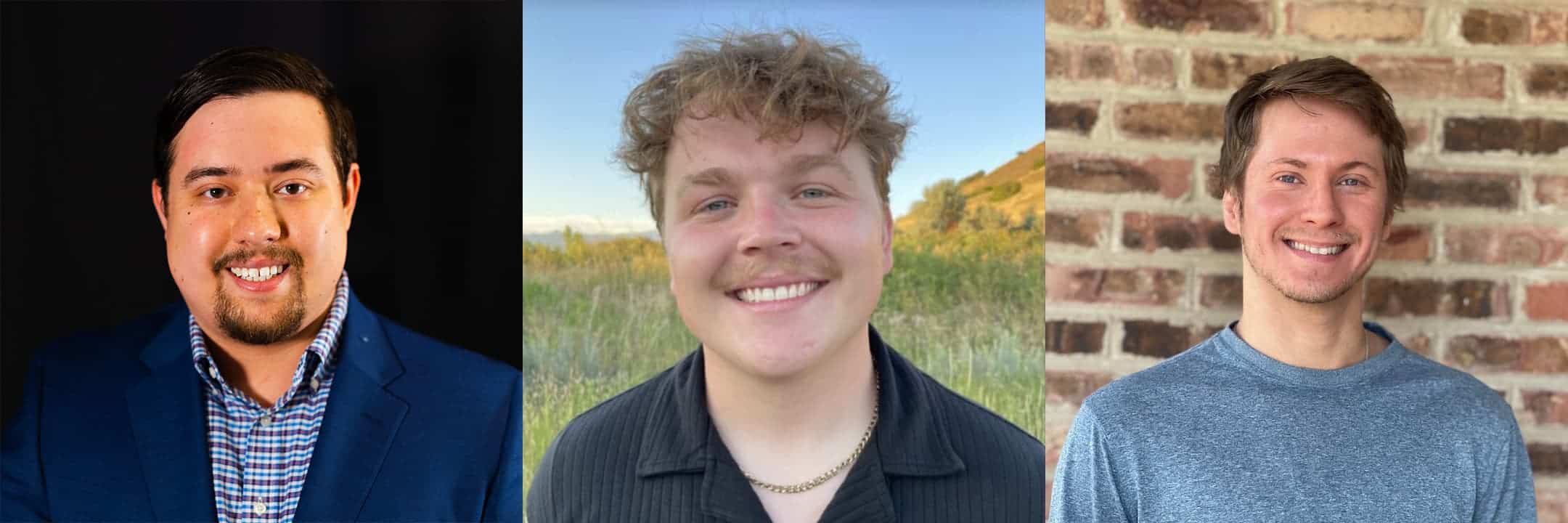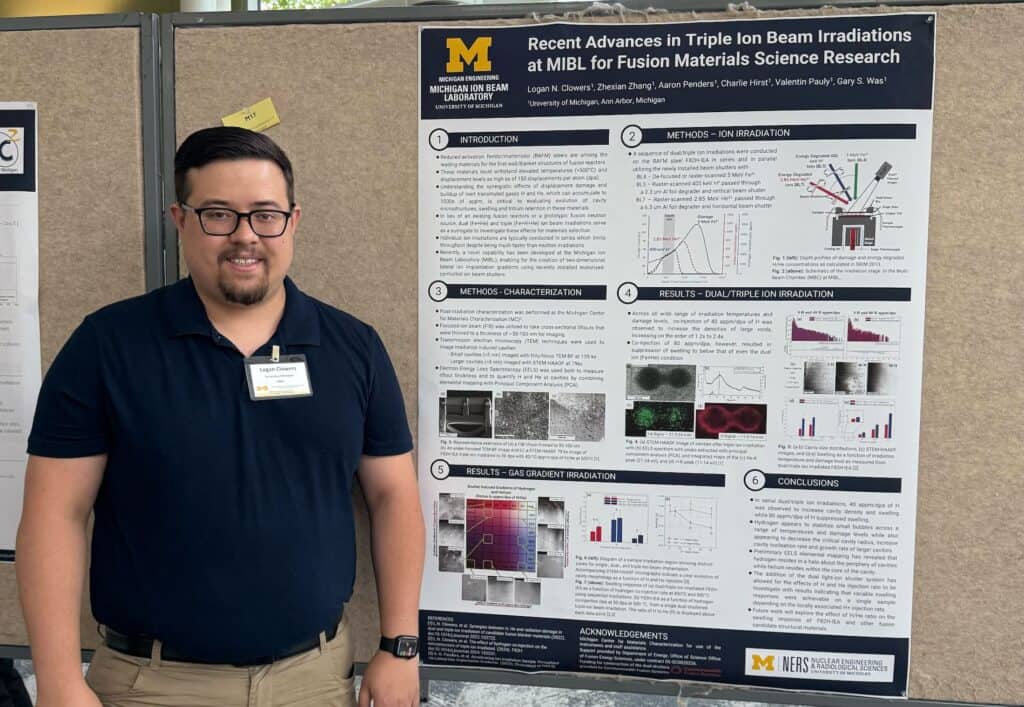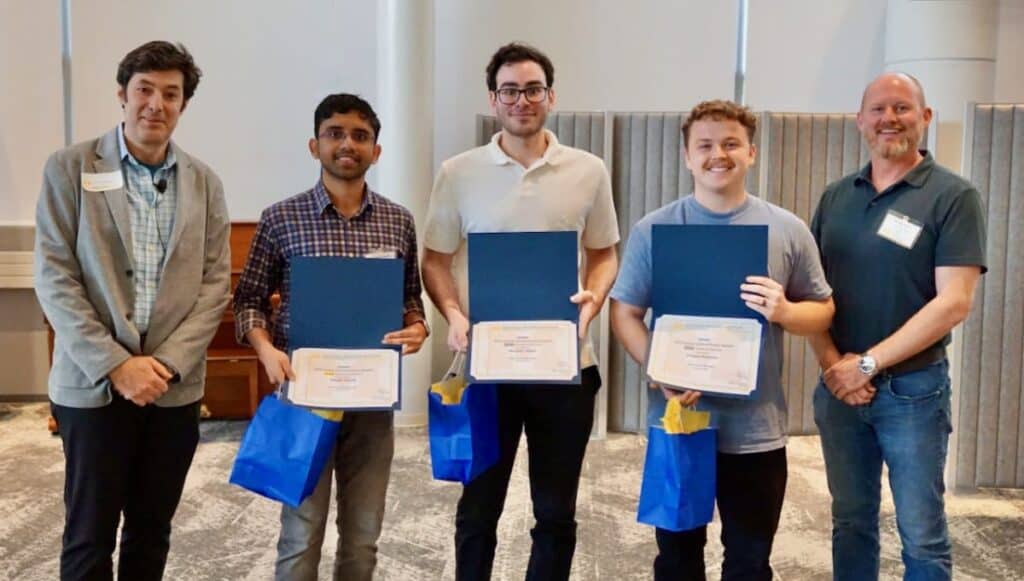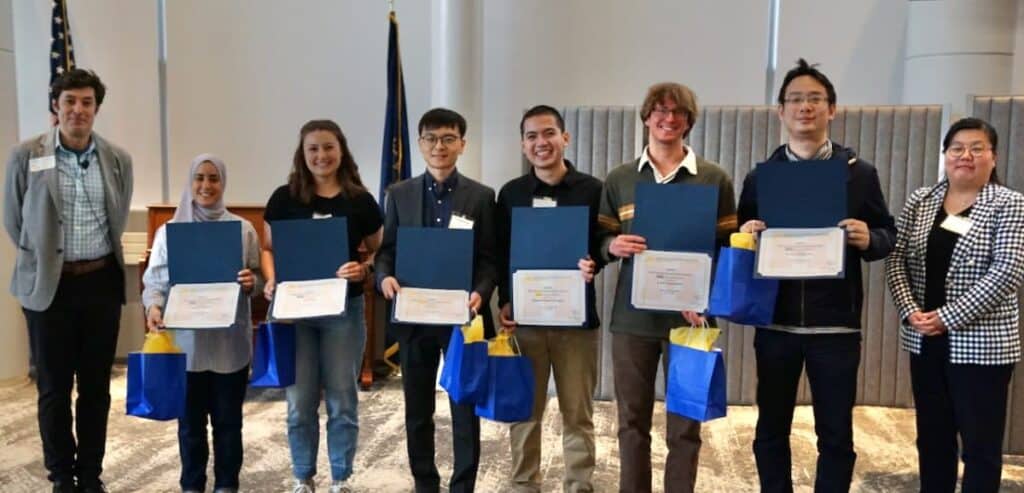
NERS students recognized for outstanding research at 2025 MMRI poster symposium
Three students affiliated with NERS were honored for their poster presentations.

Three students affiliated with NERS were honored for their poster presentations.
Logan Clowers and Crewse Petersen, graduate students in the Department of Nuclear Engineering and Radiological Sciences (NERS) were recognized for their exceptional research at the 2025 MMRI-(MC)² Summit Poster Symposium, held June 3–4, 2025. Lucas Trojanowski, an Applied Physics student in NERS professor Y Z’s group was also recognized.
The annual summit is hosted by the Michigan Materials Research Institute (MMRI), an initiative that supports the university’s goal of being a global leader in materials science. MMRI catalyzes interdisciplinary collaborations, develops and deploys advanced research infrastructure, and partners with national laboratories, government agencies, and industry to advance cutting-edge materials research.

Logan won a Gold Poster Award for his presentation, Recent Advances in Triple Ion Beam Irradiations at MIBL for Fusion Materials Science Research. Logan, whose research is advised by NERS professor emeritus Gary Was, focuses on materials degradation under extreme radiation environments.
Logan’s poster showcases both highlights from his PhD research and years of dedicated work by himself and several postdocs in his group, including Zhexian Zhang, Aaron Penders, and Charlie Hirst. Their research seeks to gain a mechanistic understanding of a key challenge affecting the resiliency of structural materials in fusion reactors: the formation of gas-filled cavities caused by the buildup of hydrogen and helium.
The group conducts its work at the Michigan Ion Beam Laboratory (MIBL), one of the few facilities in the world capable of studying these phenomena through simultaneous triple ion irradiations. For his thesis, Logan has completed more than 30 such experiments, each requiring 14 to 56 hours of continuous monitoring.
To improve throughput, the team recently developed a novel method using motorized ion beam shutters. These precisely controlled devices enable the creation of two-dimensional lateral ion implantation gradients on a single sample, allowing tens or even hundreds of unique irradiation conditions to be tested within a single experiment.
“This development aims to help us as researchers to save time and resources and streamline the arduous process of running multiple well-controlled ion irradiation experiments,” said Logan.
Innovations in experimental design like this—alongside advances in materials characterization and AI-assisted detection of irradiation-induced defects—bring us closer to a future where materials qualification is no longer a bottleneck in developing and licensing new reactor concepts. These advancements help close the gap between designing and building the next generation of nuclear reactors.
“The MMRI symposium was a great opportunity for my peers and I who conduct experiments at the (MC)² to share our research with each other,” said Logan. “Being recognized with this award bolsters not only my pride in my thesis research but also my that in the hard work of the many professors, postdocs, students and laboratory staff who constantly work together to elevate our facilities at MIBL and (MC)² to world-class status.”

A Silver Poster Award was presented to Crewse for his poster, Novel Refractory HEAs as Candidate Molten Salt Reactor Materials. Crewse is advised by Assistant Professor Stephen Raiman and is part of the MiHTEE Lab. His research explores the potential of high-entropy alloys for use in advanced reactor systems.
The MiHTEE Lab specializes in investigating material performance in high temperatures and extreme environments. One of those extreme environments is the molten salt reactor, which is a next-generation design of nuclear reactors that promises to be a safe and efficient source of power.
“We wanted to investigate how new materials, such as high entropy alloys, would fare in this environment,” said Crewse. “When developing my poster, I tried to show the promise of these materials for this application and how they could be used to increase the lifetime of a molten salt reactor.”
Crewse hopes his research demonstrates that molten salt reactors are within reach—and that we already have promising materials to support the continued development of safer, more efficient nuclear technologies.
“It is always fun to present the work I spend most of my time pursuing,” said Crewse. “It is great getting feedback from peers and discovering new insights into my research. And of course, being recognized with an award shows the hard work I have put in and the interest there is in nuclear energy in general!”

Another Silver Poster Award was earned by Lucas, who researches in the Z Lab at NERS. Lucas’s poster, Molecular Origin of Nanoscale Ordering of LiTFSI Electrolytes, investigates the fundamental behaviors of lithium salt-based electrolytes, offering insights relevant to energy storage and battery systems.
Lucas’s work focused on newly developed electrolytes composed of LiTFSI—a lithium salt commonly used in battery electrolytes—dissolved in water. In this solution, the TFSI anions tend to organize into long chains or clusters, creating nanoscale heterogeneity. This results in regions within the liquid that are rich in water and others that are rich in TFSI.
“As a result, the lithium Li+ cations can freely flow through the water-rich areas of the electrolyte and make the system very conductive, even if the concentration is very high and the overall solution is very viscous,” said Lucas. “We wanted to understand why these LiTFSI systems exhibit this self-ordering phenomenon and see if we could enhance/suppress it in similar electrolytes.”
Lucas designed his poster to clearly communicate the evidence of anion clustering, even to those unfamiliar with the experimental methods. He then explained how this clustering contributes to the high conductivity of the electrolytes. Once viewers understood the importance of anion self-assembly, he described how different solvents influence the process: water, with two hydrogen bonding sites, strongly promotes self-ordering; methanol, with one hydrogen bonding site, supports ordering to a lesser extent; and acetonitrile, which lacks hydrogen bonding sites, does not facilitate the ordering at all.
“If there’s one idea I hope people take away from my poster, it’s that in LiTFSI electrolytes and similar systems, hydrogen bonding between the TFSI and the solvent is critical for forming the clusters we studied,” said Lucas. “Understanding this principle could help scientists design safer, more powerful, and longer-lasting next-generation batteries.”
Lucas appreciated the opportunity to share his collaborative research with Northern Illinois University and Argonne National Lab at the MMRI summit, and to learn about the diverse and exciting work being done across the U-M campus.
“I was quite happy to show our results and explain our findings to others, especially those from different research focuses or backgrounds,” said Lucas. “It was an honor that our findings received special recognition among so much impressive research, and I was very proud of the recognition the summit organizers afforded my presentation.”
Their success at the MMRI symposium highlights the depth and innovation of student research within NERS and reflects the department’s continued leadership in advancing materials for next-generation energy systems.